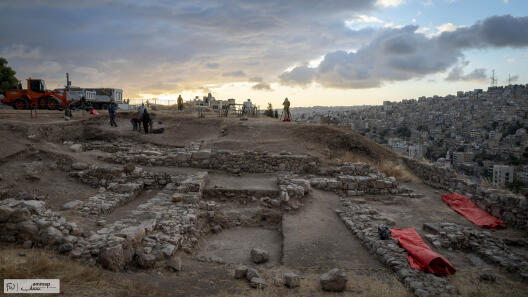Amman Citadel Excavation

The renewed excavations, which started in the spring of 2024, focus on the lower terrace of the Amman Citadel, where initial findings have revealed substantial architectural remains, particularly from the Iron Age and Hellenistic periods—eras that have received less attention than others during previous research on the Citadel. Although the site prominently showcases Roman, Byzantine, and Umayyad remains, the lower terrace holds remnants of the Iron Age and early Hellenistic occupations that were pivotal in the Citadel’s history. Our current excavation framework is guided by a series of research questions focused specifically on these two periods.
An Iron Age royal palace?
Previous excavations on the lower terrace indicate that this area may have once housed an upscale residence dating to the Late Iron Age. Key architectural features, such as a large courtyard, spacious dimensions, and a toilet room, support this idea. Artifacts like a rare glass bowl, finely crafted tableware, and ivory and glass inlays further suggest an elite function for the building, possibly even a royal palace. A primary goal of our current work is to test this hypothesis and explore whether this structure can even be identified as a royal residence.
Absolute chronology and pottery typology
An integral goal alongside studying the potential Late Iron Age palace is to establish a refined chronology for the monumental structures. By using absolute dating methods, we aim to clarify the building's periods of occupation, which may also offer insights into the fate of Rabbot-Ammon during the Neo-Babylonian period and reveal whether the structure continued in use into the Persian and Hellenistic period. Additionally, we want to work on a detailed pottery typology for the site that could serve as a valuable reference work for pottery studies across northern Transjordan.
Hellenistic fortifications
For the Hellenistic period, we aim to understand better the fortification strategies that defended Philadelphia, as Amman was known in the Ptolemaic period. This investigation targets a gap in current knowledge about Amman’s defensive role during conflicts between the Ptolemaic and Seleucid powers.
Preceding occupation phases
While the end of the monumental Iron Age building is significant, equally important are its beginnings and the role the Citadel played during the establishment of the Iron Age kingdom of Ammon. Understanding the preceding periods of the Early Iron Age, as well as the Late and Middle Bronze Ages, is crucial. Therefore, a long-term goal of our excavations is to explore the strata beneath the already excavated structures, which will provide valuable insights into the settlement on the Amman Citadel during the Bronze Age.

Ground Penetrating Radar (GPR) survey conducted by Eastern Atlas, Berlin© ammap/Katharina Schmidt Ground Penetrating Radar (GPR) Survey 2021
In December 2021, a Ground Penetrating Radar (GPR) survey was carried out on the lower terrace of the Amman Citadel. Led by Katharina Schmidt (at this time German Protestant Institute of Archaeology) and Zeidan Kafafi, and funded by the GPIA Amman, the survey was conducted by Eastern Atlas, Berlin. The results revealed potential archaeological features and areas of modern disturbance. These findings guided our excavation plans, identifying promising areas to explore and areas with significant modern intrusions to avoid.
The 2024 Excavation Campaign

Overview of the amman citadel excavation areas 2024 before the campaign© ammap The 2024 excavation season focused on expanding our understanding of the southern edge of the Citadel’s lower terrace. We selected the excavation site based on the previous research and completed it by an architectural study with photogrammetry and structural analysis in the easternmost terrace. This research aimed to document previously uncovered structures in new detail.
Four areas, designated A, B, C, and D, were excavated in the south. The core excavation site, centered within and around the former trenches, provided opportunities to establish a comprehensive archaeological sequence. In Area A, we aimed to establish a completely new sequence from surface to depth. We focused in Area B on verifying stratigraphy and creating detailed profiles, extracting short-lived C14 samples, and collecting block samples for micromorphology analysis. Areas C and D to the west and north extended the excavation area to explore the potential northern expansion of the palace and investigate storage rooms to recover additional artifacts and inventories.
Three major findings marked this season:
Chronology: Excavations revealed that the monumental building had at least two primary phases, with evidence of remodeling retaining its spatial organization. Numerous short-lived C14 samples, carefully extracted and analyzed, will allow precise dating of these phases.
Preceding Structure: In the western area, an older, monumental structure emerged, featuring a massive north-south wall exceeding 10 meters in length, suggesting sustained monumental construction activity.
Finds: Key finds included a burnt ivory volute fragment, a bone spoon, Tridacna shell pieces, and a horse head from a rider figurine, all dating to the late Iron Age and hinting at an elite context. The season’s highlight was the discovery of two more exemplars of the double-faced female head. This extraordinary discovery, captured on-site by a National Geographic team, will soon feature in an upcoming documentary. The two heads were immediately restored by the ammap team with the help of conservation specialist Franco Scorillo and will soon be exhibited in the Amman Citadel Museum.

The Team of the ammap 2024 campaign© ammap/Felix Wolter

